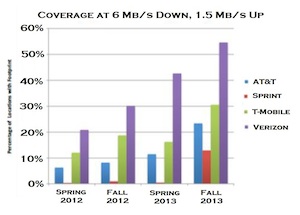
Click for a bigger version.
Mobile broadband is better in California, and improvements have been made quickly. That was one of the takeaways from a meeting of Central Coast Internet service providers and California Public Utilities Commission staff in Seaside last week. Jim Warner, a network engineer at U.C. Santa Cruz and chair of the Central Coast Broadband Consortium’s technical expert group, discussed his analysis of results from the latest round of the CPUC’s mobile broadband field testing.
“Performance has doubled in year”, Warner said, albeit with the recognition that the statewide results do not necessarily give a good picture of what’s going on in rural areas. Although there are some aspects of the CPUC’s conclusions “that would cause a statistician’s eyebrows to twitch”, overall the assessment of mobile carrier performance and adjustments made to account for actual user experiences are sound, as he later explained in a note…
CPUC staff use their average measured speed as the advertised speed since cellular carriers generally don’t specify speed the same way that their wireline brethren do. One way to think about this is: If the CPUC used the average, users could expect Internet performance that met the California target half the time. That is not what consumers expect. Shifting the measurement by one standard deviation allows the expectation of meeting the service level to be raised to perhaps 80 percent. Making some allowance for availability of reliable service seems appropriate.
Even so, perceived improvements could well be temporary.
“Traffic will grow to fill the pipes”, he said. “That’s the story of the Internet for the last 30 years. What looks served today will look underserved tomorrow”.
